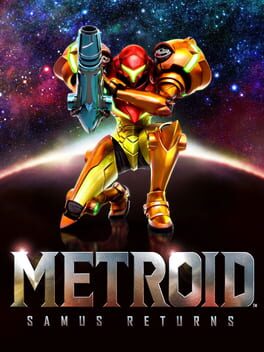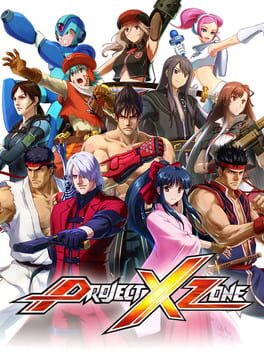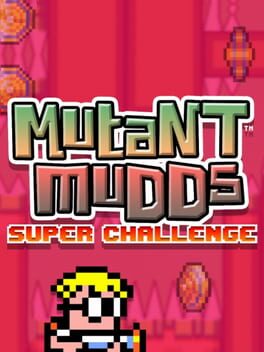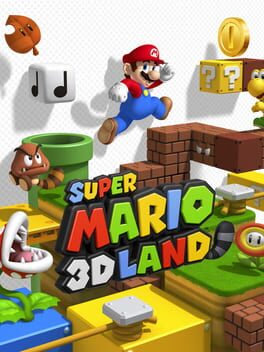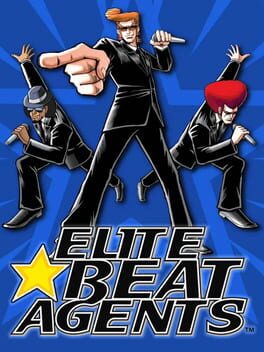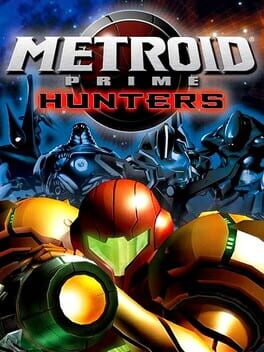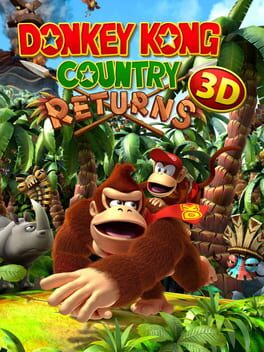ann3lid
I love metroid so gd much. This laid some really great foundations for what Dread would explore. The parry and movement speed of Samus make navigating the world so much fun. I've seen complaints about the metroids bosses becoming repetitive but I found that they switch them up enough to keep it fresh.
2012
Luigi's Mansion: Dark Moon is a game that strives to adapt the environmental puzzle solving of the first title to a handheld experience; unfortunately, most of the changes make this title less satisfying to play than the first in the series.
The biggest offender in this regard is the episodic style of the gameplay, which plucks you out of the experience just when you're beginning to feel immersed. The first title was about methodically exploring a mansion full of puzzles and engaging in Ghostbusters style combat with a varied cast of enemy ghosts (more on this later...). The combat is still here and is, in fact, improved through the addition of the dark light which adds some depth to ghost encounters. Unfortunately, the episodic structure really clashes with the idea of thoroughly exploring each environment. This is mostly due to the gems, which function as the main reward for exploration. Each level has a gem that can be collected and which appears only in that level. This is despite the fact that locations are often returned to between missions leading you to find the secret location of a gem, but unable to pick it up because you are not on the correct mission. Aside from collectibles, though, the episodic structure generally just makes the missions feel somewhat contrived. The original title showcased that highly interactive spaces can make up for a shorter run time and some missions feel like they are padding out the experience rather than adding to it.
The ghost designs were another big sticking point for me and something I remember feeling strongly about when the game first released. In the original title, normal ghosts were punctuated by bosses which were each unique in their design and gameplay approach. These designs gave the game flavor and made the mansion feel more like a real place. In Dark Moon, these boss designs are replaced by Possessors, a class of ghost with a repeated design, but an interesting gimmick: they can possess anything near them. With so many options, they must implement them in an exciting way, right? ...right?! In reality, the possessors end up possessing a staircase, a clock, and other mundane objects and their fights boil down to sucking up the possessor three times. The possessors were a great idea, but they aren't used effectively here.
Although this review has been pretty negative up to now, it's not all bad for this title. The signature expressivity of Luigi is brought back and enhanced in this title and his character is one of the reasons I kept playing. If you idle during a mission for long enough, he even starts humming along to the background music. Touches like that go a long way in terms of adding charm to the experience. I also think that the introduction of several mansions was an overall positive. It allows the environmental puzzles to be more elaborate and the environments themselves to be more visually distinct.
Overall I wouldn't say this is a bad game, just a misguided one and certainly weaker than the first in the series. If you're looking for a cutesy on-rails experience akin to a dark ride at a theme park, you could do far worse. I am doubtfully optimistic that some of these aspects may be changed in the HD remake for the Switch, but only time will tell.
The biggest offender in this regard is the episodic style of the gameplay, which plucks you out of the experience just when you're beginning to feel immersed. The first title was about methodically exploring a mansion full of puzzles and engaging in Ghostbusters style combat with a varied cast of enemy ghosts (more on this later...). The combat is still here and is, in fact, improved through the addition of the dark light which adds some depth to ghost encounters. Unfortunately, the episodic structure really clashes with the idea of thoroughly exploring each environment. This is mostly due to the gems, which function as the main reward for exploration. Each level has a gem that can be collected and which appears only in that level. This is despite the fact that locations are often returned to between missions leading you to find the secret location of a gem, but unable to pick it up because you are not on the correct mission. Aside from collectibles, though, the episodic structure generally just makes the missions feel somewhat contrived. The original title showcased that highly interactive spaces can make up for a shorter run time and some missions feel like they are padding out the experience rather than adding to it.
The ghost designs were another big sticking point for me and something I remember feeling strongly about when the game first released. In the original title, normal ghosts were punctuated by bosses which were each unique in their design and gameplay approach. These designs gave the game flavor and made the mansion feel more like a real place. In Dark Moon, these boss designs are replaced by Possessors, a class of ghost with a repeated design, but an interesting gimmick: they can possess anything near them. With so many options, they must implement them in an exciting way, right? ...right?! In reality, the possessors end up possessing a staircase, a clock, and other mundane objects and their fights boil down to sucking up the possessor three times. The possessors were a great idea, but they aren't used effectively here.
Although this review has been pretty negative up to now, it's not all bad for this title. The signature expressivity of Luigi is brought back and enhanced in this title and his character is one of the reasons I kept playing. If you idle during a mission for long enough, he even starts humming along to the background music. Touches like that go a long way in terms of adding charm to the experience. I also think that the introduction of several mansions was an overall positive. It allows the environmental puzzles to be more elaborate and the environments themselves to be more visually distinct.
Overall I wouldn't say this is a bad game, just a misguided one and certainly weaker than the first in the series. If you're looking for a cutesy on-rails experience akin to a dark ride at a theme park, you could do far worse. I am doubtfully optimistic that some of these aspects may be changed in the HD remake for the Switch, but only time will tell.
I remember enjoying the original on the 3DS for what it was when it originally released and also remember a significant amount of hype for the game before it came out. However, it must have been a pretty slow period for the handheld because this feels way worse than I remember.
The movement is extremely stiff and the jetpack doesn't help out in that regard. I really enjoy tough platformers but the character has to feel good to control and the difficulty can't feel too unfair. Unfortunately, neither holds true here, and the gun promotes a pretty boring gameplay style of camping and shooting at enemies until the screen is cleared, then progressing.
Ends up feeling like a flash game that I would have had fun with for an afternoon and then forgotten soon after, not a premium eshop title for the 3DS.
The movement is extremely stiff and the jetpack doesn't help out in that regard. I really enjoy tough platformers but the character has to feel good to control and the difficulty can't feel too unfair. Unfortunately, neither holds true here, and the gun promotes a pretty boring gameplay style of camping and shooting at enemies until the screen is cleared, then progressing.
Ends up feeling like a flash game that I would have had fun with for an afternoon and then forgotten soon after, not a premium eshop title for the 3DS.
2011
Is this the best Mario game ever made?
Certainly not
Is this underrated for what it brought to the series?
Certainly
This game aimed to provide a bite sized platforming experience that combined some of the best aspects of 2D and 3D mario design and it succeeded in that.
This is a Mario game and there aren't any big surprises when it comes to the story and the gameplay. Mario feels as good to control as ever and all of the environments you explore are really polished and have a cute diorama-esque look to them. The diorama idea is used in hidden areas and select levels which use optical illusions and clever perspectives, respectively, to incentivize use of the 3D slider on the system in the most effective way I've seen.
The biggest additions to the gameplay are the barrel roll, a ground roll which has been added to Mario's moveset and the reworking of the Tanooki suit and Boomerang suit in a 3D context. The Tanooki suit is a fantastic addition and feels like it was made for traversing 3D levels. It can make the game, which is already on the easier side, a tad too easy for my taste, but it's a great all-rounder power up that deserves its spot in the game. The boomerang suit is a bit of a flop for me since it's usually strictly worse than the fire flower, but its ability to pick up items was occasionally useful. I would have loved if the boomerang could be used as a jump extender (something done later with Cappy in Super Mario Odyssey).
On my first playthrough I was worried that the first 8 worlds were all the game had to offer. The game is already targeted towards a younger audience, but then in the last 2 worlds, the game started introducing more unique environments like the clockwork level (7-4) and I was craving more. Thankfully, there is a whole second half to the game which remixes previous levels and adds some new ones. These levels are much more difficult than in the first half and were a blast to play through. Since each set of levels is gated by the number of star coins you've collected, there's also great incentive to return to past levels.
As with any Mario game, the boss fights are its weakest link and are particularly lackluster here with Boom Boom making his 3D debut alongside Pom Pom who is a reskin with a slightly altered moveset. The Bowser fights take on the typical 2D style where you have to skirt under him until you collapse the bridge behind you, but are trivialized by your ability to move in 3D around him.
Overall, this game is an effective merger of both Mario design philosophies: the snappiness and precision of 2D Mario paired with the exploration and movement of 3D Mario. Everything done here would, for the most part, be done even better in the sequel, Super Mario 3D World, but as a proof of concept and a handheld platformer, Super Mario 3D Land is well worth returning to next time you're craving your Mario fix on-the-go.
Certainly not
Is this underrated for what it brought to the series?
Certainly
This game aimed to provide a bite sized platforming experience that combined some of the best aspects of 2D and 3D mario design and it succeeded in that.
This is a Mario game and there aren't any big surprises when it comes to the story and the gameplay. Mario feels as good to control as ever and all of the environments you explore are really polished and have a cute diorama-esque look to them. The diorama idea is used in hidden areas and select levels which use optical illusions and clever perspectives, respectively, to incentivize use of the 3D slider on the system in the most effective way I've seen.
The biggest additions to the gameplay are the barrel roll, a ground roll which has been added to Mario's moveset and the reworking of the Tanooki suit and Boomerang suit in a 3D context. The Tanooki suit is a fantastic addition and feels like it was made for traversing 3D levels. It can make the game, which is already on the easier side, a tad too easy for my taste, but it's a great all-rounder power up that deserves its spot in the game. The boomerang suit is a bit of a flop for me since it's usually strictly worse than the fire flower, but its ability to pick up items was occasionally useful. I would have loved if the boomerang could be used as a jump extender (something done later with Cappy in Super Mario Odyssey).
On my first playthrough I was worried that the first 8 worlds were all the game had to offer. The game is already targeted towards a younger audience, but then in the last 2 worlds, the game started introducing more unique environments like the clockwork level (7-4) and I was craving more. Thankfully, there is a whole second half to the game which remixes previous levels and adds some new ones. These levels are much more difficult than in the first half and were a blast to play through. Since each set of levels is gated by the number of star coins you've collected, there's also great incentive to return to past levels.
As with any Mario game, the boss fights are its weakest link and are particularly lackluster here with Boom Boom making his 3D debut alongside Pom Pom who is a reskin with a slightly altered moveset. The Bowser fights take on the typical 2D style where you have to skirt under him until you collapse the bridge behind you, but are trivialized by your ability to move in 3D around him.
Overall, this game is an effective merger of both Mario design philosophies: the snappiness and precision of 2D Mario paired with the exploration and movement of 3D Mario. Everything done here would, for the most part, be done even better in the sequel, Super Mario 3D World, but as a proof of concept and a handheld platformer, Super Mario 3D Land is well worth returning to next time you're craving your Mario fix on-the-go.
2006
Elite Beat Agents is a wacky rhythm game designed by a Japanese studio with an obvious affinity for western culture. The game is a fun time, but the experience is ultimately carried by its absurdity rather than its rhythm gameplay.
As a trio of government agents, you are tasked with helping people across the world with their dilemmas. These dilemmas range from minor (e.g., helping a jock impress his babysitting high school crush) to world ending (the final level has you thwarting an alien invasion). The way you help these folks? By tapping along to the beat, of course!
In addition to the bizarre scenarios you find yourself in, the music adds another dose of strange to the atmosphere. Surprisingly, for a nintendo published title, the levels don't use original tracks. Rather, they use famous (covers of) western pop hits from across the decades, ranging from Avril Lavigne to Madonna. The pairing of the scenarios along with the off brand music is where I found the bulk of my enjoyment while playing this game.
Elite Beat Agents is competent and responsive when it comes to the gameplay, but makes some choices which I didn't find to be satisfying. EBA gameplay uses the vocal track as the basis for its rhythmic tapping. This made me feel like I was at a disadvantage when playing a song I wasn't already familiar with. To their credit, most of these songs are well-known and loved, but losing due to an unexpected vocal hook never felt great. Since the vocal track tends to be more unpredictable in its rhythm, I also found myself glued to the bottom screen most of the time, trying to figure out when to tap next rather than paying attention to the elaborate cut scene unfolding on the top screen. These gripes are by no means game breaking, but they did deflate the experience a little.
There are at least 4 difficulties to choose from and I found the middle 2 to be the most satisfying experience. The "easiest" difficulty was made harder by the need to simplify the vocal rhythms into fewer notes whereas the hardest difficulty (that I unlocked), would put me at risk of carpal tunnel syndrome if I kept playing. If you are looking to check this game out, I would recommend starting out on the 2 star difficulty and going from there.
Elite Beat Agents is not my favorite rhythm game on the DS (Rhythm Heaven forever!), but it's competent at what it does and unique enough that I would still recommend checking it out if you have the opportunity.
As a trio of government agents, you are tasked with helping people across the world with their dilemmas. These dilemmas range from minor (e.g., helping a jock impress his babysitting high school crush) to world ending (the final level has you thwarting an alien invasion). The way you help these folks? By tapping along to the beat, of course!
In addition to the bizarre scenarios you find yourself in, the music adds another dose of strange to the atmosphere. Surprisingly, for a nintendo published title, the levels don't use original tracks. Rather, they use famous (covers of) western pop hits from across the decades, ranging from Avril Lavigne to Madonna. The pairing of the scenarios along with the off brand music is where I found the bulk of my enjoyment while playing this game.
Elite Beat Agents is competent and responsive when it comes to the gameplay, but makes some choices which I didn't find to be satisfying. EBA gameplay uses the vocal track as the basis for its rhythmic tapping. This made me feel like I was at a disadvantage when playing a song I wasn't already familiar with. To their credit, most of these songs are well-known and loved, but losing due to an unexpected vocal hook never felt great. Since the vocal track tends to be more unpredictable in its rhythm, I also found myself glued to the bottom screen most of the time, trying to figure out when to tap next rather than paying attention to the elaborate cut scene unfolding on the top screen. These gripes are by no means game breaking, but they did deflate the experience a little.
There are at least 4 difficulties to choose from and I found the middle 2 to be the most satisfying experience. The "easiest" difficulty was made harder by the need to simplify the vocal rhythms into fewer notes whereas the hardest difficulty (that I unlocked), would put me at risk of carpal tunnel syndrome if I kept playing. If you are looking to check this game out, I would recommend starting out on the 2 star difficulty and going from there.
Elite Beat Agents is not my favorite rhythm game on the DS (Rhythm Heaven forever!), but it's competent at what it does and unique enough that I would still recommend checking it out if you have the opportunity.
Metroid Prime is a series known for adapting the engrossing atmosphere and puzzle-like exploration of the 2D metroid titles into a first person, 3D perspective. It’s not known for its list of successful spin-offs. However, my potentially hot take is that this is the best of those spin-offs.
Hunters was designed as a direct response to the boom in multiplayer-focused FPS titles during the mid 2000’s. Evidence of this ranges from the multiplayer focus of Hunters to the “Headshot!” text that appears in-game when you make your mark. The multiplayer focus was the main marketing draw, promising local and online deathmatches and, at the time, exciting features like voice chat. To add variety, a cast of space bounty hunters with unique weapons, abilities, and morph ball-esque forms were introduced. Unfortunately, this aspect of the game can no longer be experienced the way it was designed, but my memories of this mode are very fond. Each hunter has a unique style of play and local matches were always a blast. These character designs are really strong and it’s a shame that they haven’t been used more since!
When playing alone, the promise of this game was a stripped back, handheld metroid prime campaign. Despite the technical limitations of the system, I think this was mostly delivered on. Some rooms feel repetitive and long hallways or slow doors often mask loading times, but given the game’s 2006 release, I still find it surprising how technically competent it is. Hunters takes a level based approach by having you visit several points of interest across the Alimbic System. Each of these areas feels distinct and the music enhances the sense of atmosphere in each of them. In each area, you’re tasked with unlocking a portal to the boss, defeating said boss, and escaping in a set amount of time. It’s simple, but functional, if a little repetitive (especially when it comes to the boss fights). Throughout these levels you may come across a hunter who you’ll fight or pick up one of the hunter’s weapons. The level based approach, mixed with the hunters and their varying weaknesses to the weapons give this the flavor of a Mega Man game. The missed opportunity here was not having the hunters themselves act as the boss for each mission.
This game is not for everyone. The controls are kind of wonky and the stellar quality of other Prime titles makes it a hard recommendation. Nevertheless, this is a unique take on Metroid Prime and doesn’t get the credit it deserves from fans of the series. Even though it’s highly unlikely, a Hunters sequel with full dual stick controls, a campaign that leans into the Mega Man vibes of the original, and a fully modern online multiplayer mode is something I want desperately. If you’re interested in what Samus was up to between Metroid Prime 1 and 2, I think you’ll find a fun distraction in Metroid Prime Hunters, and a multiplayer mode begging to be revived.
Hunters was designed as a direct response to the boom in multiplayer-focused FPS titles during the mid 2000’s. Evidence of this ranges from the multiplayer focus of Hunters to the “Headshot!” text that appears in-game when you make your mark. The multiplayer focus was the main marketing draw, promising local and online deathmatches and, at the time, exciting features like voice chat. To add variety, a cast of space bounty hunters with unique weapons, abilities, and morph ball-esque forms were introduced. Unfortunately, this aspect of the game can no longer be experienced the way it was designed, but my memories of this mode are very fond. Each hunter has a unique style of play and local matches were always a blast. These character designs are really strong and it’s a shame that they haven’t been used more since!
When playing alone, the promise of this game was a stripped back, handheld metroid prime campaign. Despite the technical limitations of the system, I think this was mostly delivered on. Some rooms feel repetitive and long hallways or slow doors often mask loading times, but given the game’s 2006 release, I still find it surprising how technically competent it is. Hunters takes a level based approach by having you visit several points of interest across the Alimbic System. Each of these areas feels distinct and the music enhances the sense of atmosphere in each of them. In each area, you’re tasked with unlocking a portal to the boss, defeating said boss, and escaping in a set amount of time. It’s simple, but functional, if a little repetitive (especially when it comes to the boss fights). Throughout these levels you may come across a hunter who you’ll fight or pick up one of the hunter’s weapons. The level based approach, mixed with the hunters and their varying weaknesses to the weapons give this the flavor of a Mega Man game. The missed opportunity here was not having the hunters themselves act as the boss for each mission.
This game is not for everyone. The controls are kind of wonky and the stellar quality of other Prime titles makes it a hard recommendation. Nevertheless, this is a unique take on Metroid Prime and doesn’t get the credit it deserves from fans of the series. Even though it’s highly unlikely, a Hunters sequel with full dual stick controls, a campaign that leans into the Mega Man vibes of the original, and a fully modern online multiplayer mode is something I want desperately. If you’re interested in what Samus was up to between Metroid Prime 1 and 2, I think you’ll find a fun distraction in Metroid Prime Hunters, and a multiplayer mode begging to be revived.
I picked this up when it launced, made it to around the King Pridemoor fight, and then put it down. After picking up Shovel Knight Dig, I had an itch to go back to the franchise proper and it made perfect sense to return to the one campaign I had never finished. I can't believe what I was missing out on!
Everything about this game is firing on all cylinders. The levels are all a joy to play and manage to flip how you think about your spin-move constantly (especially some of the side areas in the Mole Knight levels). All of the new (and old) NPCs are hilarious and in particular I have to mention the step dad-like relationship King Knight has with King Pridemoor and his Mom. The music is, as usual, quite catchy and well-composed but longtime fans of the series might be disappointed to hear some direct repeats from the previous entries in the mix.
One of the main new features in this campaign is Joustus which is a card game that serves both as a welcome distraction from the action-oriented levels and also plays a prominent role in the plot. In fact, King Knight's whole reason for going on his adventure is to become the titular King of Cards. While I've really grown to love Joustus, I found it to be really frustrating when I first started. I think part of this is due to the fact that some of the nuance of the card game goes unexplained within the game and also because you are able to face off against some opponents early on when you have a deck that realistically cannot compete against them. For me, the key was to realizing that Joustus should primarily be played reactively (e.g., focusing on removing opponents cards from gems rather than on placing your own cards on gems) and that the graveyard should be really treated as an extension of the board and is crucial for creating "locks" in the board that will secure gems.
Aside from my minor grievances with how Joustus is taught to the player, I think that Shovel Knight: King of Cards is both a fantastic standalone game while also brilliantly complementing the other Shovel Knight campaigns. I would recommend this game to anyone who is fan of platformers and/or card games, period.
Everything about this game is firing on all cylinders. The levels are all a joy to play and manage to flip how you think about your spin-move constantly (especially some of the side areas in the Mole Knight levels). All of the new (and old) NPCs are hilarious and in particular I have to mention the step dad-like relationship King Knight has with King Pridemoor and his Mom. The music is, as usual, quite catchy and well-composed but longtime fans of the series might be disappointed to hear some direct repeats from the previous entries in the mix.
One of the main new features in this campaign is Joustus which is a card game that serves both as a welcome distraction from the action-oriented levels and also plays a prominent role in the plot. In fact, King Knight's whole reason for going on his adventure is to become the titular King of Cards. While I've really grown to love Joustus, I found it to be really frustrating when I first started. I think part of this is due to the fact that some of the nuance of the card game goes unexplained within the game and also because you are able to face off against some opponents early on when you have a deck that realistically cannot compete against them. For me, the key was to realizing that Joustus should primarily be played reactively (e.g., focusing on removing opponents cards from gems rather than on placing your own cards on gems) and that the graveyard should be really treated as an extension of the board and is crucial for creating "locks" in the board that will secure gems.
Aside from my minor grievances with how Joustus is taught to the player, I think that Shovel Knight: King of Cards is both a fantastic standalone game while also brilliantly complementing the other Shovel Knight campaigns. I would recommend this game to anyone who is fan of platformers and/or card games, period.
A port of an already fantastic platformer that adds some quality of life features to improve it even more. As a revival of the classic DKC franchise, it gets what made the originals so great (challenging platforming, a vibrant score), but refreshes the formula for a modern audience. One of the best platformers for the 3ds.
